When Potensic launched the Atom drone in September 2023, I was excited that yet another company realized how important the sub-250g market segment is for hobbyists and casual users to enjoy drone flying without bureaucratic hurdles. In many countries, drones that weigh under 250 grams (0.55lb) are exempted from aircraft registration and the need for a pilot license.
In this Potensic ATOM review, I’ll focus on what makes this drone so user-friendly and perfect for newbies and intermediate pilots on a budget. In the last two weeks, I have had over twenty flights to test its flight performance in various conditions. Wind resistance Level 5 (up to 24 mph) is as advertised, and the Potensic ATOM can fly in these conditions with no problem. Of course, it drifts a lot, and controls become less responsive as the drone fights against strong wind gusts.
The Potensic ATOM includes an ultra-stable three-axis gimbal equipped with a 1/3-inch SONY CMOS camera. Considering its friendly price, I was surprised it has manual camera settings and RAW capabilities.
Potensic ATOM review
Disclosure: I received this 250g class drone for a product review collaboration with Potensic. Although the parts were offered for free, all opinions in this article remain my own, and the sponsor in no way influenced me. They had a few special requirements to ensure that my review would reflect the actual capabilities of their drone, such as:
1. The flight test will be taken on a sunny day with a blue sky and no wind (as I fly only on the weekends, this was the most challenging part)
2. We would like dedicated videos, so no comparison sections or videos with other brand
3. If possible, we hope you can help run a range test in an open field
4. Please inform us ahead of time if you experience issues during the flight rather than post the article/video out (I liked that during the review process, I was contacted twice by them to ask if everything was ok or if I had any questions/problems with which they could help.)
Potensic sent me the Fly More combo edition with two extra batteries, a charging hub, and other goodies, including a handbag to store and carry the drone with all its accessories. The bag has velcro dividers inside and a large zipped pocket outside. Tons of spare propellers with mounting screws are also provided. I hope l will never have to use them. An elastic velcro band holds propellers together when stored in the bag.
From a physical point of view, the Potensic Atom is very similar to other drones in its weight class. With folded arms, it measures just 88x143x58 mm (3.5×5.6×2.3 in) and weighs 241 grams, including a battery and micro SD card. It has four super-bright charging level indicators, two TOF distance sensors, and one optical flow sensor on the belly. The micro SD slot is located on the back, right under the battery. It has a safety lock that ensures accidentally ejecting the battery mid-flight.
The F2.2 4K camera is mounted on a 3-axis gimbal stabilizer concealed beneath a plastic lens protector, which must be removed before flighting. A black bar in the front (nose) could be confused with a frontal obstacle avoidance system. Unfortunately, it is just part of the design without any functionality.
Pricing, availability, and package options
The Atom drone is available at Potensic’s online store in two package options:
- The Standard kit costs $299 and includes the drone, a remote controller, one flight battery, four pairs of spare propellers, eight spare screws, a screwdriver, a gimbal cover, a USB-C charging cable, and three RC-Phone cables (micro USB, USB-C, and a Lightning connector).
- The Fly More Combo kit shown in this review costs $399 and includes two additional batteries, a fast-charging hub with an AC/DC adaptor, even more spare props, a practical shoulder bag, and a 64MB micro SD card (Limited-time bonus).
The Atom and Atom SE drones are also available on Potensic’s official Amazon store.
I advise people facing this choice to consider how long they will likely be flying. For 100 bucks, the fly more combo triples the flight time. Of course, you can upgrade later, but it will cost you much more, as just the charging hub with two batteries costs $134.99.
How good is the Potensic Atom camera?
The Atom’s camera features a 12MP 1/3-inch Sony CMOS sensor and a fixed f/2.2 aperture lens that provides a 78-degree field of view (FOV). The camera is installed on a 3-axis mechanical gimbal, delivering superior image stabilization compared to the Atom SE’s electronic image stabilization (EIS).
The Potensic Atom has no internal storage but relies on an SD card, which is more convenient as it is removable and upgradable (up to 128GB is supported / UHS-3 rating required). Video can be captured in 4K (3840×2160) up to 30fps, 2.7K up to 30fps, and 1080p up to 60fps in the H.264 codec (MPEG-4 AVC – 50mbps). It can take 12MP (4608×2952) still photos in JPG (compressed) or RAW (DNG) + JPG formats.
For drone photographers who like to tweak camera settings in order to make the perfect shot, the Potensic Atom allows ISO, Shutter Speed, and White Balance manual settings. Of course, if you are lazy like me, you can leave everything on auto and let the drone do all the work.
The low angle of the winter sun amplifies the exposure control problems and lack of HDR features. It would be best to prioritize the sky or ground view by changing the gimbal’s tilt angle. I didn’t simultaneously get a decent view (proper exposure) of both. If you have a tilted horizon problem, you can re-calibrate the gimbal.
Potensic Atom: Remote controller and range
The Atom is packed with a compact remote controller (model DSRC02A) that has foldable antennas and removable stick ends (stored at the bottom of the RC). The handgrips at each end extend outwards to accommodate a smartphone. The data cable between the radio and phone is nicely routed through a ditch in the right handle. Potensic includes Micro USB, Type-C, and Lightning cables covering Android and iOS devices.
The power button and four charging level indicator LEDs are on the left handler, and the RTH/Pause button is on the right. In addition to the two shoulder buttons (Video and Photo), it has a gimbal control dial. The controller can be held comfortably and is pretty straightforward to use. Its built-in 3000mAh battery lasts about 120 minutes (four flights). Oddly, phones draw a charge from the controller, affecting overall battery life.
Potensic’s third-generation PixSync transmission technology promises a maximum video transmission of up to 6km (3.7 miles). In many countries, you can fly only in the line of sight mode (LoS – aircraft within visual distance), so this range is more than you could wish for.
I made the flight range test for every drone I reviewed in the same place -an unpopulated open field, far from any airport, without obstacles and too much RF noise. The control distance varies widely depending on the flight altitude. At 70 meters, I flew 2722 meters far from me when fail-safe RTH was triggered. The first “Poor signal, please fly carefully” warning message appeared on the screen at 2580 distance -from this point, the FPV signal also became intermittent (laggy/choppy). During the test, my phone was set to “Airplane mode“.
The video above was captured with Mobizen from my phone’s screen and shows the journey of my range test.
Potensic Atom: Battery, Charging options, and Flight time
The Potensic ATOM is powered by a 2230mAh rechargeable LiPo battery (DSBT02B) with a 7.7V nominal voltage. The battery pack weighs 84 grams and has Type-C power for direct charging. The Fly More combo kit includes three flight batteries and a parallel charging hub, allowing simultaneous refueling of up to three batteries. Each battery has its own set of charging indicator LEDs, so you always know which one is ready to use.
Potensic advertises the ATOM drone as having a flight time of 32 minutes per charge. In real-world flying conditions, you can expect a battery life of 25-28 minutes, which is still impressive for such a small drone. During my hovering battery life test, the drone stayed in the air for 26 minutes. When the drone made a forced landing due to low battery, it still had 15% energy left, which could provide you with four more minutes of flight. I do not recommend pushing the batteries to their limits; over-discharging can dramatically reduce their lifespan.
Is the Potensic Atom easy to fly?
The short answer is Yes! The Potensic Atom flies beautifully stable out of the box. Before the first flight, you must perform compass calibration (rotating the drone on its vertical and horizontal axis). It is recommended to repeat this step when flying at a location farther than 50km (31 miles) from the area where the drone was last flown.
By default, the drone starts in beginner mode, in which flight speed is limited to 6m/s and a geofence is activated (flight distance\altitude limit). For newbies, practicing a couple of flights in this mode is recommended. It’s always important to watch the weather forecast when flying a drone, especially sub250-class ones like the Atom. However, it does a surprisingly great job of keeping the camera steady in windy conditions.
Its built-in GPS module (essential for stable flying and accurate RTH) is fast and precise. It requires at least seven satellites to take off safely. I was surprised to see it found 23 sats in just a few seconds.
The ATOM has three flight speed modes to choose from:
- Video: 2m/s, descent speed: 2m/s, flight speed: 6m/s
- Normal: 4m/s, descent speed: 3m/s, flight speed: 10m/s
- Sport: 5m/s, descent speed: 4m/s, flight speed: 16m/s
Being speedy and too agile, Sport mode is recommended only if you want to fly fast from one point to another. For aerial filming, I suggest using Video mode. To make gimbal movements more cinematic, I slowed down the “Pitch speed” to 10°/s.
The Atom drone has several automated flight modes that allow cinematic shots proficiency with a single click. From the mobile App, you can access the following QuickShot modes: Pull-Away, Rocket, Circle, Spiral, and Boomerang. The video above shows exactly what each mode does.
During the flight, you’re accompanied by the PotensicPro APP that shows telemetry data such as aircraft orientation, current airspeed, drone altitude, remaining battery life, and signal strength. Switching from FPV to map view lets you display the drone’s location relative to roads and landmarks.
Landing the Potensic Atom drone is easy -you just have to hold the descent lever (left stick in mode 2) down or press the land virtual button on the screen. I tested the return-to-home (RTH), and even in breezy weather, the aircraft returned within two meters of the take-off point and began to land.
Firmware upgrade
On my second weekend with the Atom drone, the APP prompted that a new firmware was released. The updated process was straightforward; it is made on autopilot after you accept everything. Flight controller, Gimbal, Remote controller, Camera, and Video transmissions are updated individually.
The latest Potesic Atom firmware brings the following improvements and bug fixes:
- Flight Control:
- Optimized the control strategy for operations near the ground.
- Improved the assisted landing experience.
- Camera:
- Optimized the blue tint issue caused by the auto white balance in some scenes.
- Improved color quality of the camera.
- Optimized video clarity.
- Transmission:
- Optimized the anti-interference performance for video transmission in some scenes.
- Battery:
- Optimized the low-temperature protection logic.
- Gimbal:
- Optimized the stability of yaw adjustment.
- Optimized the smoothness of the gimbal when braking.
- Optimized other known issues.
Atom vs Atom SE comparison table
The Atom has been significantly improved from the Atom SE. It has a longer range (6K vs 4K), one minute longer flight time, and the newer 3-axis stabilized camera. The Atom also features more autonomous flight modes (including visual tracking) than its “SE” brother.
| Atom | Atom SE | |
| Camera Stabilization | 3-axis gimbal | 1-axis EIS |
| Video Resolution | 4K@30/25/24fps 2.7K@30/25/24fps 1080P@60/50/30/25/24fps |
4K@30fps 2.7K@30fps 1080P@30/60fps |
| ISO/Shutter Speed/White Balance Setting | Manual+Auto | Auto |
| FOV | 78° | 118° |
| Tracking Method | Smart Visual Tracking | GPS Tracking |
| Intelligent Flight Modes | QuickShots-Pull-away, Rocket, Circle, Spiral, and Boomerang; Visual Tracking, WayPoint | Follow Me, Circle Flight, WayPoint |
| Transmission Range | 6km | 4km |
| Flight Time | 32mins | 31mins |
| Price | Standard: $299 Fly more combo: $399 |
Standard: $229 Fly more kit: $259/$310 |

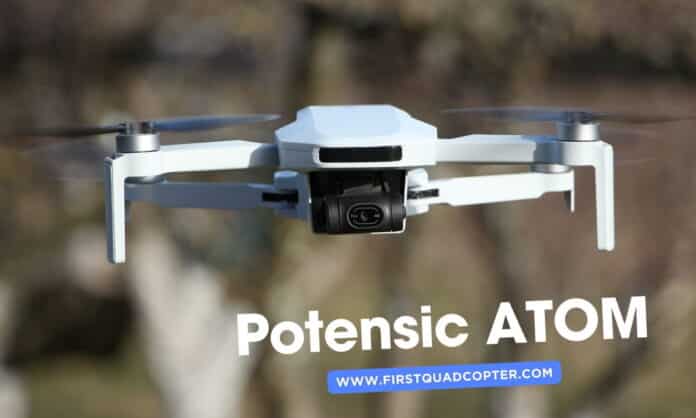
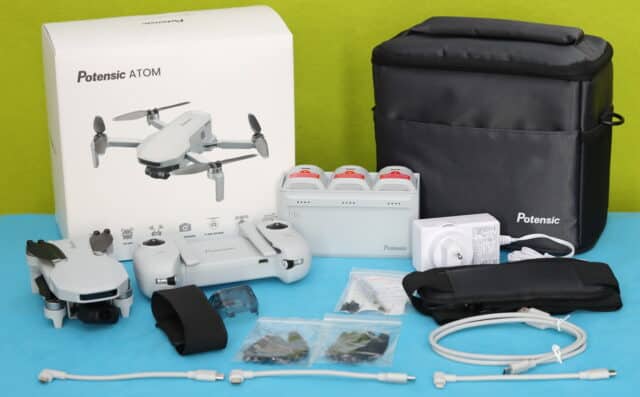
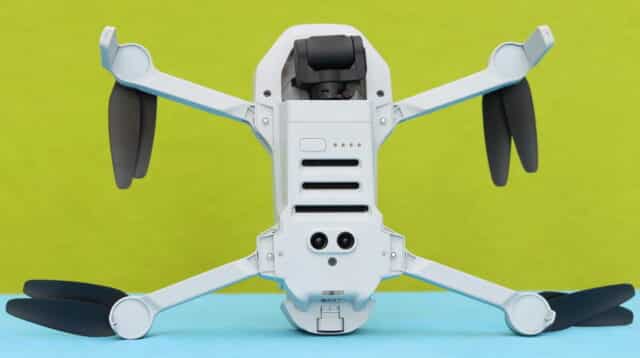


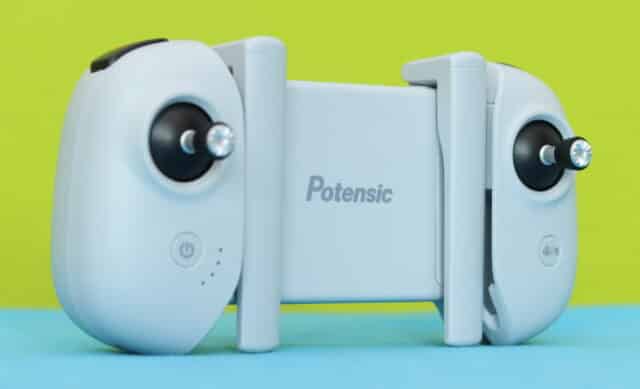


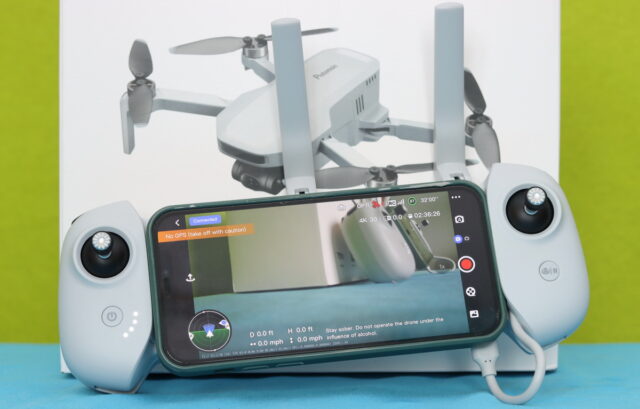

Any extension phone/controller cables available so you can use a headset (one where you put your phone into) such as a Drone Mask 2?
You can use any standard Type C to Type C (Android) or Type C to Lighting (Apple) cable!
Are quickshot modes (circle, rocket…) customizable?
Yes, you can adjust distance and other parameters!
Potensic never be DJI, but their drones are pretty solid for their money.
I truly love my Potensic Atom.
Hi, can I fly my Potensic Atom in UK? Any registration needed?
Here https://register-drones.caa.co.uk/ you can find all the details how to fly legally drones in the UK.
When use the Potesic Atom, even being under 250grams you still need to follow some general rules:
– Never put people in danger. Even small drones and model aircraft could injure people if you don’t fly them safely.
– Do not fly closer to people than 50m
– Fly below 120m (400ft)
– Stay well away from airports, airfields, spaceports and aircraft
Thank you!
Thanks!